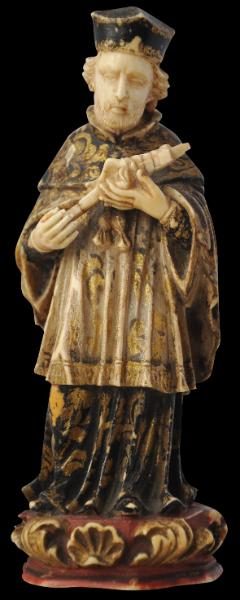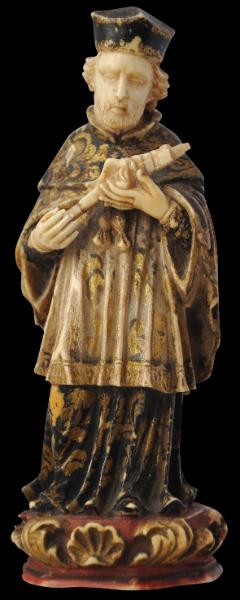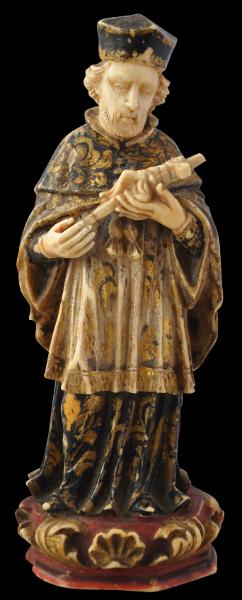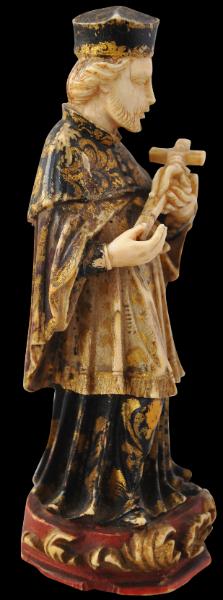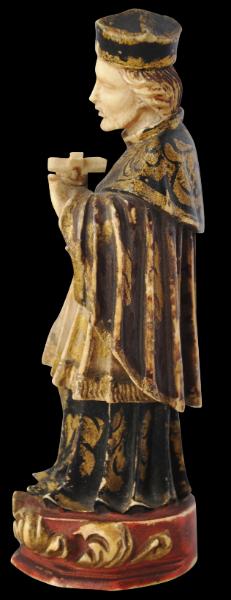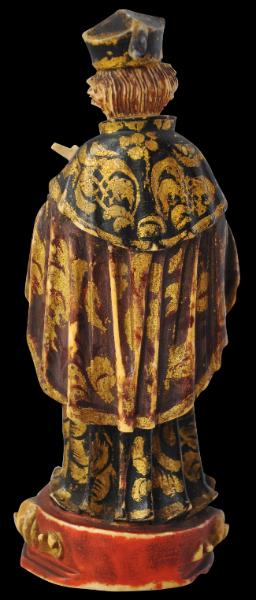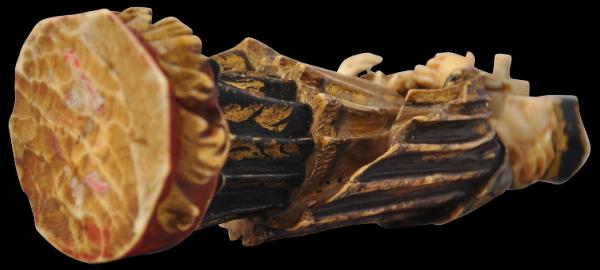This finely carved Spanish colonial solid ivory image of St Francis Xavier, a co-founder of the Jesuits who evangelised in India, Southeast Asia, China and Japan, most probably is from the Philippines, or from Goa. Many and possibly most colonial religious ivory figures were painted with polychrome, although the polychrome usually has worn away leaving only small traces. This example is unusual for the extent of polychrome that it does retain.
The image shows St Francis Xavier with the pointed beretta-style hat of the Jesuits, with a caped cassock, and a finely featured face with carefully carved hair and beard. He is shown looking down at a crucifix which he holds in his hands in a pose that is typical of how St Francis Xavier is shown and is an identifying characteristic. He stands on a platform carved at the front with a pilgrim’s scallop shell and foliate swirls.
Carved ivory images of St Francis Xavier are not common, indeed, Trota Jose (1990, p. 43) observes that ivory images of Jesuit saints generally are ‘rather rare’.
The condition of this example is very good. A small chip to the base appears to have been over-painted, and there is a larger chip to the back of the image’s head (this chip has been darkened to make it less obvious). But otherwise the image’s features including his fine fingers and nose are without damage. The extent of the surviving polychrome is unusual.
Francis Xavier (1506-1552) was born Francisco de Jasso y Azpilicueta into an aristocratic family in the Kingdom of Navarre (now split across Spain and France). He co-foundered the Society of Jesus (the Jesuits).
He went to study at the Collège Sainte-Barbe in Paris in 1525 where he met Ignatius of Loyola. Together with Loyola and five others, he founded in 1534 the Society of Jesus. The seven made a vow of poverty, chastity and obedience, and vowed to convert non-Christians in the East, and failing that, to carry out the wishes of the Pope.
Xavier devoted much of his life to missions in Asia, after being appointed by King John III of Portugal to take charge as Apostolic Nuncio in Goa, the Portuguese entrepot in India, where the king believed that Christian values were eroding among the Portuguese.
Xavier left Lisbon for Goa in April 1541 along with two other Jesuits and the new Viceroy Martim Afonso de Sousa. He had a six month stay in Mozambique on the way. He reached Goa in May 1542 and spent three years there where he founded the Jesuit’s first mission in Asia.
Thereafter Xavier commenced his extraordinary journeys to the rest of Asia. He travelled to South India, Sri Lanka and then to Malacca in what today is Malaysia and then to Ambon, Ternate and Morotai islands in what today is Eastern Indonesia. He returned to Goa, then sailed back to Malacca and then on to Japan and Canton, establishing Jesuits missions and converting local people to Christianity as he went.
He died of fever in China in 1552 and was buried on Shangchuan Island. In 1553, his body was taken to Malacca where it was reburied in Saint Paul’s church. Later that year, it was removed again and taken to Goa, Ultimately it was installed in Goa’s Basilica of Bom Jesus.
The right forearm, used by Xavier to bless and baptize his converts, was detached in 1614 and taken to Rome where it remains on display in a silver reliquary at Il Gesu, Rome’s main Jesuit church. Another of Xavier’s arm bones was taken to Macau where it was kept in a silver reliquary.
References
Trota Jose, R., Images of Faith: Religious Ivory Carvings from the Philippines, Pacific Asia Museum, 1990.


